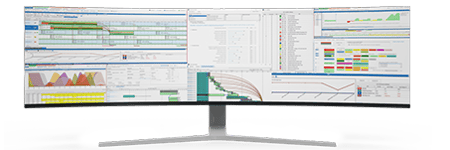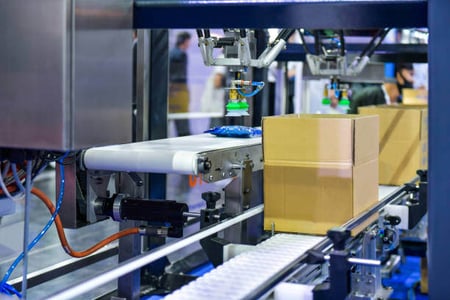Driving Efficiency with Continuous Manufacturing in Packaging Facilities
In packaging manufacturing, staying competitive means embracing new technologies and methods that enhance efficiency and reduce costs. One of the most impactful methodologies is continuous manufacturing, a process that emphasizes seamless production to minimize downtime, improve resource utilization, and increase throughput.
For production planners in packaging facilities, the adoption of continuous manufacturing, integrated with advanced planning tools like PlanetTogether and enterprise systems such as SAP, Oracle, Microsoft, Kinaxis, or Aveva, offers a transformative approach to optimizing operations.

Continuous Manufacturing in Packaging
Continuous manufacturing replaces traditional batch production with a streamlined process where production flows without interruption. This approach ensures that raw materials are consistently converted into finished products with minimal stops. In the context of packaging, where demand often fluctuates and customer-specific customization is common, continuous manufacturing enables planners to achieve:
Improved Scalability: Quickly adapt production volumes to meet market demand.
Enhanced Quality Control: Maintain consistent product quality by minimizing process variability.
Reduced Waste: Lower material wastage by optimizing production flow and reducing setup time.
Higher Efficiency: Eliminate non-value-adding activities, such as waiting or frequent equipment adjustments.

Challenges in Implementing Continuous Manufacturing
Despite its benefits, transitioning to continuous manufacturing poses several challenges for packaging facilities:
Complex Scheduling: Managing multiple production lines with varying speeds and requirements.
Demand Volatility: Balancing fluctuating customer demands while maintaining a smooth production flow.
Integration Needs: Aligning production systems with enterprise software for real-time data sharing.
Resource Allocation: Ensuring materials, labor, and equipment are optimally utilized without creating bottlenecks.
This is where the integration of advanced planning and scheduling software like PlanetTogether with enterprise resource planning (ERP) systems such as SAP, Oracle, Microsoft, Kinaxis, or Aveva becomes critical.
![]()

Integrating PlanetTogether with ERP Systems for Continuous Manufacturing
The synergy between PlanetTogether and leading ERP systems empowers production planners to overcome the challenges of continuous manufacturing. Here’s how this integration supports packaging facilities:
Real-Time Visibility and Decision-Making
Integration Benefits: PlanetTogether provides a dynamic scheduling environment, allowing real-time adjustments based on shop floor events. When integrated with SAP or Oracle ERP, it enables seamless synchronization of production schedules with procurement, inventory, and order management data.
Impact: Planners gain immediate visibility into production statuses, inventory levels, and customer orders, enabling them to make informed decisions that prevent delays and bottlenecks.
Enhanced Demand Forecasting
Integration Benefits: Systems like Kinaxis offer advanced demand planning and forecasting capabilities. Combined with PlanetTogether, planners can align forecasts with production schedules to create a more predictable manufacturing environment.
Impact: Continuous manufacturing thrives on consistency. Improved demand forecasting ensures that production lines remain balanced, reducing the risk of overproduction or shortages.
Optimized Scheduling and Resource Utilization
Integration Benefits: With Microsoft Dynamics, planners can integrate financial, supply chain, and production data into a unified view. PlanetTogether takes this further by optimizing schedules based on real-time constraints, such as machine availability and labor shifts.
Impact: Continuous manufacturing demands precise scheduling. This integration ensures that every resource is utilized efficiently, minimizing idle time and maximizing throughput.
Improved Collaboration Across Departments
Integration Benefits: Aveva's manufacturing execution systems (MES) excel at connecting the shop floor with corporate operations. When paired with PlanetTogether, it bridges the gap between high-level planning and ground-level execution.
Impact: Seamless communication between production, procurement, and sales teams ensures alignment across the organization, reducing miscommunication and fostering a culture of collaboration.
Sustainability and Waste Reduction
Integration Benefits: Many ERPs, like Oracle and SAP, incorporate sustainability modules. By integrating with PlanetTogether, planners can monitor and reduce energy consumption, optimize material usage, and track waste reduction initiatives.
Impact: Sustainability goals are increasingly important in packaging. Continuous manufacturing, supported by such integration, minimizes waste and energy usage, contributing to long-term environmental benefits.
For production planners in packaging manufacturing, the transition to continuous manufacturing can seem daunting. However, the right combination of strategy, technology, and integration can turn this challenge into an opportunity. PlanetTogether’s advanced planning capabilities, when paired with leading ERP systems, provide a powerful solution to streamline operations, improve resource utilization, and enhance overall productivity.
By embracing continuous manufacturing, planners can position their facilities to meet the demands of a dynamic market while driving long-term efficiency and sustainability. It’s time to move beyond batch production and step into a future where every process flows seamlessly, every resource is optimized, and every customer expectation is met with precision.
Are you ready to take your manufacturing operations to the next level? Contact us today to learn more about how PlanetTogether can help you achieve your goals and drive success in your industry.
Topics: PlanetTogether Software, Integrating PlanetTogether, Enhanced Demand Forecasting, Real-Time Visibility and Decision-Making, Packaging Manufacturing, Improved Collaboration Across Departments, Optimized Scheduling and Resource Utilization





















LEAVE A COMMENT